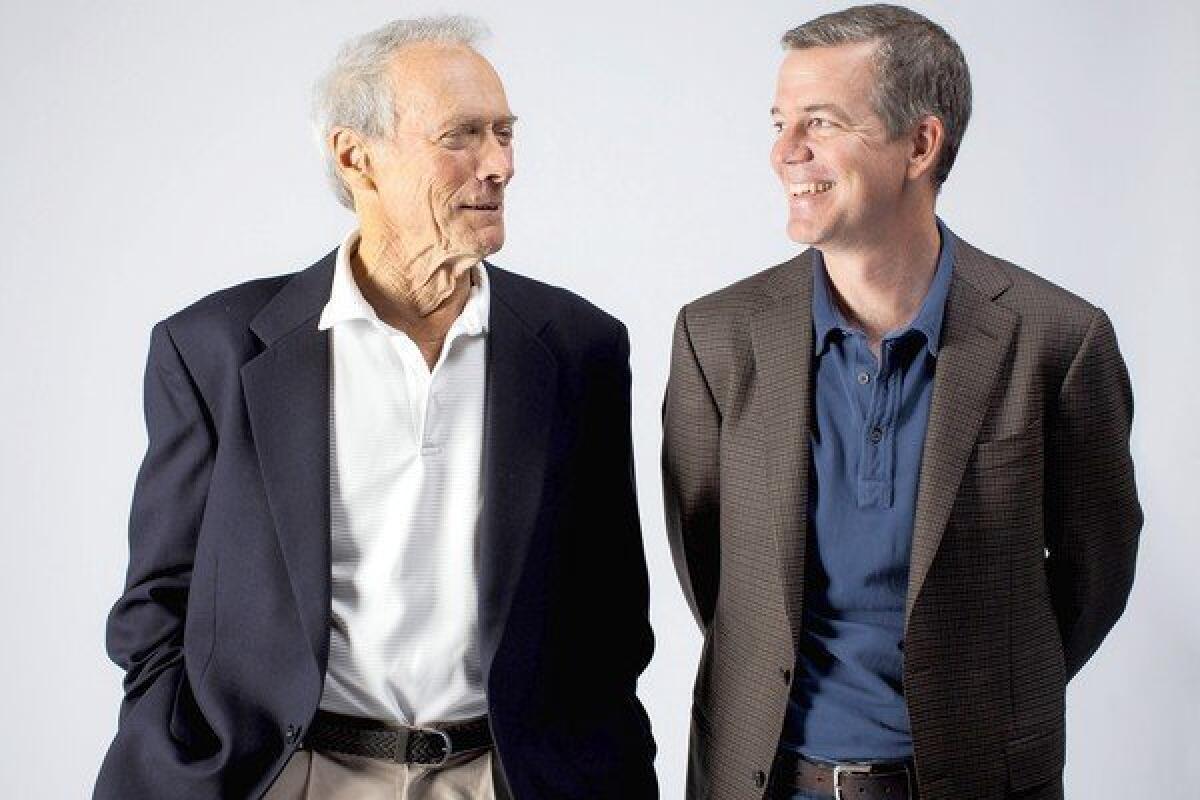For Clint Eastwood, it’s one curveball after another

- Share via
Mileage and misadventure leave their marks, but we don’t always notice the damage right away. Last Monday, for instance, Clint Eastwood had a realization that stopped him in his tracks just outside his bungalow on the Warner Bros. lot.
“Son of a gun,” the 82-year-old muttered as he leaned over his beloved 1992 GMC Typhoon and dragged an index finger over the mysterious inch-long scratch marring the forest-green paint just above the grill.
A little later, sitting among the brown-leather shadows of his office, Eastwood seemed considerably less concerned about any dents in his reputation after his eccentric, meandering speech at the Republican National Convention late last month.
PHOTOS: The movie career of Clint Eastwood
“I didn’t want to do the usual teleprompter thing.... I didn’t know what the hell I was going to do,” the genial star said of his spur-of-the-moment decision to use an empty chair as a prop representing President Obama. “If I had more time I would have organized more. Maybe, but I don’t know.”
As Eastwood related his tales of Tampa he nodded to the couch cushion next to him for effect even though it wasn’t empty — it was occupied by Robert Lorenz, the director and co-producer of “Trouble With the Curve.” The two have worked together since 1994 and when Eastwood said the Republican leadership “probably had a little apoplexy” during the speech, a winking Lorenz said he could feel their pain.
“That kind of sums up what it’s like to direct Clint Eastwood,” Lorenz deadpanned. “You never know what’s going to come out. But at least you have an advantage of having an editor afterwards.”
INTERACTIVE: Hollywood Star Walk
The two laughed together, but during the interview (and an earlier photo shoot) there were moments when Lorenz’s tight grin looked suspiciously like the silver-medalist smiles you see at the Olympics. If that was indeed the case it would be understandable — Eastwood’s screwball speech might be a strike against “Trouble With the Curve” before the movie even gets up to bat.
The movie, opening Friday in Los Angeles, stars Eastwood as the cantankerous Gus Lobel, a baseball scout who may be in the last inning of his storied career as his eyesight goes out. He needs help, but it comes from the most unlikely source: his estranged daughter, Mickey, played by three-time Oscar nominee Amy Adams.
The tightly wound Mickey is poised to claim a corner office in her elite Atlanta law firm, but she risks that by following her dad to the bleachers of a North Carolina ballpark; the risk might be worth it if she can finally unravel the reason her widower father abruptly exiled her from his life years earlier. Justin Timberlake, John Goodman, Robert Patrick and Matthew Lillard also star in the film, scripted by newcomer Randy Brown.
PHOTOS: Celebrities by the Times
No one is swinging for the fence more than Lorenz. The Chicago native has been the good soldier at Eastwood’s side since coming on as an assistant director on the “Bridges of Madison of County,” and although he received two Oscar nominations as Eastwood’s producer (“Mystic River” and “Letters From Iwo Jima” were both up for best picture), this new project is a special moment — “Curve” is his feature-film directorial debut.
For years, Lorenz has spied one thing when he’s looked to the horizon of his career: a waiting director’s chair. The 45-year-old Chicago native said this script, with a mix of humor and heartache as well as themes of career pressure and family fractures, was the ideal project.
Even better, Brown’s script presented a central role for a maverick spirit of advanced age and chronically bad attitude — in other words, a fastball down the middle for Eastwood the actor. The star was once the rangy, grizzled symbol of the Old West loner and then later the scowling agent of urban-street retribution, but now he is the embodiment of coiled geriatric rage.
Eastwood last appeared onscreen in 2008 in “Gran Torino” as Walt Kowalski, another man staring into the twilight with a scowl and clenched fists. “Get off my lawn,” Kowalski snarled, adding a surprise late-career entry to the Eastwood catchphrase collection.
“There are certain things people enjoy seeing Clint do on the screen,” Lorenz said. “You can make the characters different — and they are different — but there is a quality to the character that people enjoy seeing up on the screen, of course, so you don’t want to run from that.”
Eastwood punctuated Lorenz’s thought: “They enjoy my unpleasantness.”
Beyond sports
He might be on to something with that. “Gran Torino,” directed by Eastwood, had a production budget of $33 million and went on to gross $270 million worldwide. But the longtime box office hero isn’t motivated by commercial imperatives, and most people (himself included) expected it would be his last screen appearance considering the recent career emphasis and vigor he’s found in directing. With “Curve,” he’s acted in five films since 2000, but in that same window he’s directed 11 feature films with several gaining serious critical accolades and major trophy attention.
Eastwood is even less interested in acting in movies that he’s not directing. The last time the star appeared in front of a camera on another director’s set? Wolfgang Petersen’s “In the Line of Fire” (1993), which underlines the gesture of support Eastwood made to support Lorenz’s debut effort.
“Trouble With the Curve” finds its setting and setup in the career of Eastwood’s Lobel, a scout for the Atlanta Braves who is considered a legend and/or antique, depending on whom you ask and their age. The movie celebrates the metrics of “The Natural” and “Field of Dreams” — soulfulness, grit and respect for tradition matter as much as stolen bases — and that would seem to make it a rebuttal to last year’s “Moneyball,” which suggested that judging players by stats is the populist solution to clubhouse celebrity and cronyism.
PHOTOS: The movie career of Clint Eastwood
Lorenz and Eastwood don’t see this story as a sports movie — and indeed there are no game scenes, really, of any length or deep dramatic consequence — so they aren’t especially engaged in the idea of a World Series showdown in schools of thought.
“When I first saw it was a baseball movie I was not that excited,” Eastwood said of his part. “But then I read it and saw that really that this wasn’t a sports movie at all. And then I thought it was a perfect opportunity. I had no doubt he’d do a terrific job, and he absolutely did.”
Lorenz added key scenes that weren’t in the script, such as some evocative dream sequences of intimidating horse hooves bearing down on one of the characters as well as a flashback scene that shows a harrowing moment in Lobel family history in which a younger Eastwood gives a beat-down to a threatening stranger. (The director manipulated footage from the 1982 tech thriller “Firefox.”)
INTERACTIVE: Hollywood Star Walk
The most evocative scene in the movie is when Eastwood’s character visits the tombstone of his wife and, with wrenching authenticity, lets loose a tear-soaked apology. The director said his star stepped forward and not only delivered a heart-grabbing performance but did it after paring the scene on the page where there was just “too much going on.”
Early in the film, the difficulties of aging are announced in audacious fashion: Not many films would spend a good long visit on a man standing in his bathroom waiting to urinate and scolding and mocking his uncooperative system. It’s not your usual “senior moment” humor, but Lorenz said it was essential to show that Hollywood’s representation of aging is now beyond walkers and bingo scenes.
For moviegoers who have seen Eastwood talk to a chair in recent weeks, the new film offers the chance to add a headstone and a penis to that list of senior touchstones. Late-night show hosts are getting Christmas early perhaps.
PHOTOS: Celebrities by the Times
But how about Lorenz? He was listening to the GOP convention speech on the radio so he was especially confused when Eastwood veered off into the sight gag of speaking to an empty chair like some sort of mash-up of “Face the Nation” and “Harvey.”
Was he distressed later about the possible effects on his film? Lorenz hesitated, and Eastwood filled the space. “He was thinking maybe we shouldn’t release this movie,” the actor deadpanned as he leaned back on the couch and balanced one foot on the edge of the squat coffee table.
The response came from the not-empty seat next to him on the couch. “I’ve learned from Clint over the years that there really isn’t any such thing as bad publicity and he’s going to do what he does and go out there and be himself. Clint people love Clint, and that’s not changing. and so it’ll all be fine.” After a beat he added: “But actually this was all an awful experience, and I don’t ever want to work with Clint again.”
It was clubhouse banter, verbal backslaps and eye-pokes, but they steered clear of straightforward answers on that fraught topic and about their future work. Who will sit where — will Eastwood act, will Lorenz direct? No specifics were offered. “There will be more pictures, and I’ll be in some of them and out of others, and Rob I’m sure wants to direct more and I’ll be encouraging,” said the star.
More than a few viewers of the GOP convention wondered if Eastwood was slipping in his health or his engagement, but during the interview there was no hesitation in his thoughts or any doubt in his eyes. There was also zero interest in the opinion of Twitter writers or the judgment of the political punditry. He did reveal that he had intended to tack on another idea to his speech; he wanted to remind voters that Republican nominee Mitt Romney should be shown the door after four years if “he isn’t getting the job done either.”
The off-the-script Eastwood smiled, enjoying his trickster role, but then he grew serious talking about the thing that keeps him moving forward in a career that began several generations ago. “Every picture takes on a life of its own, and sometimes you can point to the spot in it where it happens. It’s fun,” he said. “You always learn something new about yourself every time, and sometimes about everybody else too.”
More to Read
Only good movies
Get the Indie Focus newsletter, Mark Olsen's weekly guide to the world of cinema.
You may occasionally receive promotional content from the Los Angeles Times.










